What Grows in Shade
What Plants Grow In The Shade?
An extract from our Principal's eBook, "What to Plant Where"
- One of the many bonuses of trees in the garden is the lovely cool shade they provide over summer. However, shade from large trees can also cause a range of different problems for plants and gardens.
- Reduced light can restrict plant growth. Many plants in shaded areas will appear weak and leggy, with poor flowering.
- Shaded areas are cooler than adjacent open areas. Whilst this is generally a benefit to the garden, growth in shaded areas may be slow in cool climates (e.g. this may be more of a problem in Hobart than Sydney).
- Shade encourages the growth of moss and algae on the ground (including paths), making them slippery.
- Water in shaded areas does not dry up so readily.
- Roots from large shade trees compete with smaller plants growing below them.
- Soil under trees can be quite dry, as the overhanging leaf canopy prevents water penetration.
- Foliage from some trees (e.g. conifers) may be toxic to plants below.
- Roots of some trees may give off toxins which inhibit growth of other plants (e.g. mulberry).
- Leaf or branch drop from trees may smother or damage low growing plants below.
- Trees restrict ventilation (i.e. air movement), which may encourage disease problems in shaded areas.
Plants Suited To Full Shade
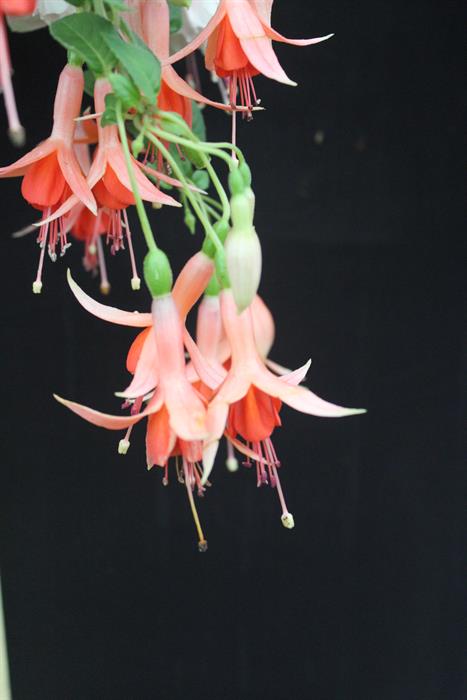
Acalypha wilkesiana
Agapanthus spp.
Bauera rubioides
Begonia spp.
Boronia mollis
Bromeliads
Camellia spp.
Chlorophytum
Clivia spp.
Convallaria (lily of the valley)
Cotoneaster dammeri
Cotoneaster dielsiana
Dampiera diversifolia
Daphne odora
Epacris impressa
Euphorbia wulfenii
Galanthus (snowdrops)
Gyneura sarmentosa
Hedera (ivy)
Helleborus (Christmas rose)
Hosta
Hydrangea spp.
Impatiens
Iresine herbstii
Iris cristata
Kennedya prostrata
Lamium spp.
Nandina domestica
Pieris japonica
Plumbago capensis
Philodendron
Primula
Ranunculus
Saxifraga
Selaginella
Tetratheca ciliata
Thryptomene
Vinca major (periwinkle)
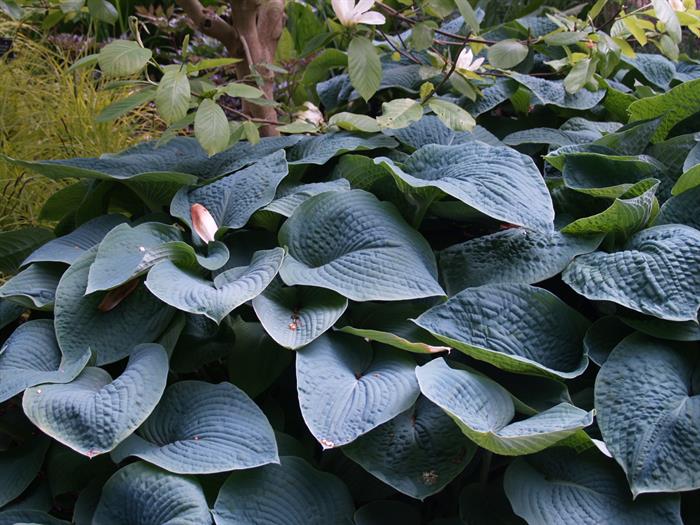
Ferns
Ferns are ideal for growing in shady areas as they are naturally adapted to growing in conditions of low light. Different varieties can tolerate different levels of shade and soil moisture, so use the following lists to choose ferns which suit your particular problem area.
Sun Tolerant Varieties
Ferns are rarely suited to full sun, though the following will perform reasonably well with some direct sunlight in morning and afternoon. They will need filtered sunlight in the hottest part of the day and at the hottest time of the year.
Hardy to full sun if soil remains moist and humidity is high:
Blechnum occidentale, Cibotium glaucum, Dicksonia antarctica, Dryopteris noveboracensis, Osmunda spp.Pteridium aquilinum, and Sphaeropteris cooperi.
Hardy with some shading in the hottest part of the day:
Davallia trichomanoides, Doodia media, Dryopteris erythrosora,Nephrolepsis cordifolia, Pellaea (most species), Platycerium (most species), Polypodium aureum, Polystichum polyblepharum, Pteris cretica, Pteris vittata and Todea barbara.
Dry Soil Ferns
All ferns perform better with cool, moist soil. Some ferns however, can tolerate drier and more exposed conditions:
Blechnum occidentale, Davallia trichomanoides, Nephrolepsis cordifolia, Polypodium aurea, Pteridium aquilinium, Pteris cretica, Pteris vittata, Woodwardia fimbriata.
Shade Trees
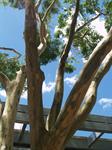
If you are looking for ways to beat the heat, the cheapest and healthiest cooling system is a shade tree. Although they have lost popularity in recent years (due to the current trend of smaller sized blocks and landscaping trends which favour compact low-growing plants) shade trees are still the best way to create a cool, comfortable garden.
The Benefits
As hot air flows through the tree, the temperature drops as moisture evaporates from the trees foliage, and oxygen levels rise. The shade provided by the tree prevents the sun’s harmful rays reaching the ground (and your body), and glare is reduced. And they’re just the direct benefits to you! A shade tree can also be an attractive landscape feature, a great place for the kids to play, and an important habitat for birds, insects and other wildlife.
What to look for when choosing a tree
- How tall will it grow? The stated height on plant labels are guidelines, not hard and fast rules – often trees will grow considerably taller or smaller.
- How dense? The denser the crown - the better its shade provision.
- How wide? Broad-canopied trees need lots of space but they provide excellent shade compared to narrow, columnar trees.
- How low does the foliage grow? If the foliage grows low to the ground, it may take up to much space, or you may have top spend time pruning back branches to provide good access beneath the tree.
- Does it cause root problems? Think about nearby drainage pipes, foundations, paths, etc.
- Is it hardy? Does it have good resistance to stress, pests and diseases?
- Does it drop leaves, branches, fruit, sap/resin or cones? All trees drop leaves, but some drop them all at once in autumn (deciduous trees e.g. Quercus palustris), and although they make a huge mess, at least it’s all over and done within a few weeks (and you have the bonus of a pile of leaves for composting and mulching). Others continually drop messy leaves throughout the year (e.g. Grevillea robusta). Some can be quite hazardous in small backyards, dropping whole branches (e.g. Eucalyptus cladocalyx, E. citriodora), pine cones or large and messy fruits. Some plants, particularly some conifers, will drop resins or sap that can be sticky or difficult to remove, or even damage some surfaces such as painted areas, or car duco.
- Does it pose a safety or health risk, such as having thorns (e.g. some Robinia spp.), cause allergies, have irritating sap, or dropping branches.
Where to Plant the Shade Tree
After you have considered the obvious, including that it won’t be in the way of paths, the driveway, buildings and the clothing line, and that it won’t interfere with underground drainage pipes or overhead wires, think about how it can be best positioned for maximum summer shade effect. Planting a tree on the northern side of the house will shade the interior rooms for much of the day; a tree on the western side will shade the house and garden when it’s generally most needed - the afternoon!
Deciduous or Semi Deciduous Trees
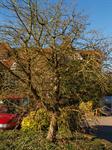 Many deciduous trees are excellent shade trees, providing shade in summer and allowing sunlight through during winter. Good examples are:
Many deciduous trees are excellent shade trees, providing shade in summer and allowing sunlight through during winter. Good examples are:
Acer negundo (ghost maple) - a hardy, fast growing tree to 6-12m tall. The cultivar A. negundo ‘Aureo-marginatum' grows to 5-6m tall, and has attractive yellow edged leaves. The cultivar A. negundo ‘Variegatum’ grows to 5-6m tall, has very attractive white margined leaves. Any non-variegated shoots should be removed as soon as they appear for these two cultivars.
Acer palmatum (Japanese maple) – a lovely small tree for the garden. Grows up to 6-8 m tall. Many varieties are available that display different leaf colours and shapes. Autumn foliage is best in cool areas in full sun. It has a fibrous root system that rarely cause problems.
Bauhinia variegata – a small tree reaching 5-10 m. Large orchid-like white or mauve flowers in early spring. It may need shaping to develop a tree-like form. It grows in many parts of Australia, but is only fully deciduous in cold areas.
Calodendrum capense – grows to 8-15 m with a broad crown. Profuse clusters of pink flowers in mid to late spring. Fully deciduous in cooler climates and areas with dry winters; evergreen elsewhere.
Caesalpinea ferea - medium sized tree to 6m with leopard-patterned bark. Showy yellows blossoms appear in spring. Best in Tropical and subtropical areas.
Caesalpinia pulcherrima – a medium shrub to small tree (up to 4 m). It has attractive red and yellow flowers in summer and autumn, and has fern-like foliage. It needs pruning in its early years to shape it into a tree form. A good shade tree for small gardens in frost-free areas (tropics and subtropics).
Delonix regia (poinciana) – grows to 10 m tall but has a much broader spread. It has bright red flowers in late spring. It has an attractive broad canopy so it need lots of space to spread. An excellent shade tree for subtropical and tropical areas only.
Fraxinus excelsior ‘Aurea’ (golden ash) – grows to 6-12m tall, with its spring and autumn foliage being golden yellow. It is also attractive in winter when it’s yellow-gold younger branches can be easily seen. Lower side shoots should be removed as they appear to promote a tree-like shape when the plant is young. A pendulous form is also available, and this is grafted onto seedling root stocks at a suitable height.
Fraxinus oxycarpa (desert ash) – grows to 10-15m tall, and is fast growing, and generally hardy in hot, dry conditions. Superior forms budded on to seedling root stocks are available.
Jacaranda mimosifolia – grows 10-15 m tall and has a broad crown. Showy mauve bell-shaped flowers in spring and fern-like leaves throughout summer. Fully deciduous in cool to mild areas; retains some foliage in warm climates.
Koelreuteria paniculata (golden rain tree) - fast growing and hardy tree to 12 m with a broad canopy. Small yellow flowers are produced in panicles in late summer followed by inflated red capsules through to autumn.
Quercus spp. (oaks) – tall trees which are best suited to larger gardens. Good autumn display in cool climates (especially the Pin Oak, Quercus palustris). Tolerates warm, hot summers but needs cool winters.
Robinia pseudoacacia (golden robinia) – grows to 10 m tall and 8 m wide. Can be fast growing in good conditions. Attractive lime-green foliage turns golden in autumn. Roots can be a problem.
Tabebuia spp. (trumpet trees) - grow around the 6-12m height range with a number of different species well suited to the subtropics. Colours of flowers are yellow, pink or mauve in clusters during spring or summer. Most are attractive shaped trees.
Liquidamber styraciflua – tall pyramid or columnar-shaped tree growing 20-30m tall and 6-8m wide. Good autumn display in cooler climates. Needs good summer rainfall.
Evergreen Shade Trees
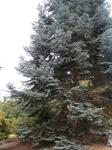 Arbutus unedo (Irish strawberry tree) - dense medium tree 6-8m tall with dark green leaves. Insignificant flowers are followed by strawberry-like fruits.
Arbutus unedo (Irish strawberry tree) - dense medium tree 6-8m tall with dark green leaves. Insignificant flowers are followed by strawberry-like fruits.
Ceratonia siliqua (carob) – a hardy, adaptable, small tree to 5-6m tall, with attractive, compound, dark green, leathery leaves. It has small, reddish flowers followed by masses of pods which are a valuable source of nutrients (sugars and proteins) for both stock and humans. It is very drought resistant.
Corymbia ficifolia (syn.Eucalyptus ficifolia) (red flowering gum) – small to medium eucalypt to 12 m tall with a broad canopy and short thick trunk. Showy red or pink flowers in summer. Attractive small shade tree for mild to cool areas with drier soils.
Harpullia pendula (tulipwood) - dense tree to 10m when grown in most gardens. Dark green shiny leaves highlight the red fruits and black seeds that attract birds.
Michelia champaca (Himalayan magnolia) - conical light green foliage tree to 15m with scented yellow-orange flowers in late summer.
Pittosporum undulatum (Aust. native daphne) - small tree to 6m but dense and wide. Leaves are wavy-edged and scented white flowers are produced in spring.
Schinus molle (pepper tree) – grows 8-10 m tall and nearly as wide – needs plenty of space to spread. A graceful tree with pendulous branches and fine leaves. Grows well in hot dry climates; also does well in cooler areas but does not like heavy, wet soil.
Spathodea campanulata (African tulip tree) – grows to 12-20 m with a broad canopy of 8-15 m. Has showy orange-red flowers in autumn and winter. Suitable for subtropics and tropics.
Syzygium spp. (Lillypilly) – medium to large trees with dense crowns and glossy dark green leaves. Fluffy white or red flowers followed by white, red or purple fruits. Very adaptable with some species growing well in temperate, subtropical and tropical areas.
Learn with ACS
There is much to learn, whether you are an inexperienced home gardener, or have more experience. We offer a wide selection of courses to suit a variety of different knowledge levels and experience. What is more, our high quality courses have been developed by highly experienced horticulturists and you can enrol on them at any time. If you would like
to know more about any of our courses, please do get in touch with us -
connect with our expert horticulture tutors today.
[20/04/2024 00:28:42]
More from ACS
Over 150 short courses, certificates and diplomas covering landscaping, crops, plants of all types and general gardening.